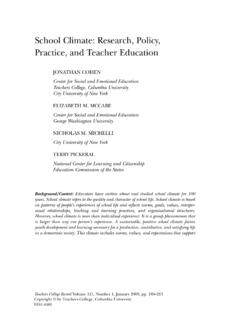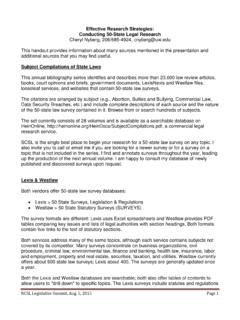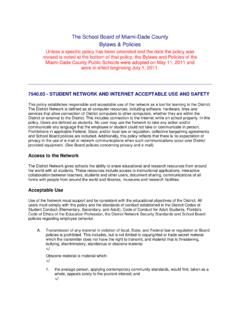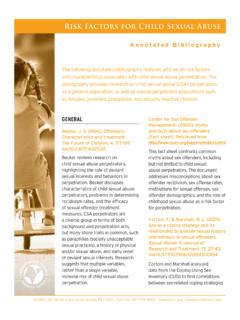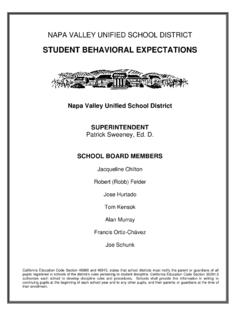Transcription of Prepared by: Issue Brief: Social and Emotional Guyn Cooper ...
1 Prepared by: Issue Brief: Social and Emotional Guyn Cooper Research Associates Commissioned by: Carthy Foundation and Max Bell Foundation Learning in Canada August 2013. Social and Emotional learning (SEL) is a framework for developing Social and Emotional competencies that is gaining interest in Canada and the United States. The purpose of this Issue brief is to provide an overview of the field of Social and Emotional learning in Canada, particularly within the education system. It presents a concise synopsis of recent research on the need for and the benefits of SEL initiatives, along with the findings from consultations with a cross-section of leaders and others working a in the fields of SEL and mental health promotion. WHAT IS Social AND Emotional LEARNING?
2 Social and Emotional learning, as described by the Collaborative for Academic, Social and Emotional Learning (CASEL), is the process of acquiring and effectively applying the knowledge, attitudes and skills necessary to recognize and manage emotions;. developing caring and concern for others; making responsible decisions; establishing positive relationships; and handling 1. challenging situations capably. The field of SEL evolved from research on prevention and resilience. The definitions of the five competency clusters for students are: Self-awareness: The ability to accurately recognize one's emotions and thoughts and their influence on behavior. This includes accurately assessing one's strengths and limitations and possessing a well-grounded sense of confidence and optimism.
3 Self-management: The ability to regulate one's emotions, thoughts, and behaviors effectively in different situations. This includes managing stress, controlling impulses, motivating oneself, and setting and working toward achieving personal and academic goals. Social awareness: The ability to take the perspective of and empathize with others from diverse backgrounds and cultures, to understand Social and ethical norms for behavior, and to recognize family, school, and community resources and supports. Relationship skills: The ability to establish and maintain healthy and rewarding relationships with diverse individuals and groups. This includes communicating clearly, listening actively, cooperating, resisting inappropriate Social pressure, negotiating conflict constructively, and seeking and offering help when needed.
4 Responsible decision-making: The ability to make constructive and respectful choices about personal behavior and Social interactions based on consideration of ethical standards, safety concerns, Social norms, the realistic evaluation of consequences of various actions, and the well-being of self and others. The authors and foundations would like to express their thanks to the many individuals who graciously contributed their time and expertise to this project. CARTHY FOUNDATION Issue BRIEF Social & Emotional LEARNING AUGUST 2013 | 1. THE PROBLEM: MANY CHILDREN AND YOUTH ARE DEALING WITH Social , Emotional , AND BEHAVIOURAL. CHALLENGES THAT HINDER THEIR SUCCESS IN SCHOOL AND IN LIFE. Many students are experiencing serious Social , Emotional , and behavioural challenges that can interfere with both teaching and 2 3.
5 Learning and are also associated with teen and adult physical violence and criminality, substance abuse and addictions, and a host 4. of other serious problems in adolescence and adulthood. Among grade 6 students in Canada in 2010, 35% of girls and 27% of boys, and 44% of girls and 28% of boys in grade 10 reported high levels of Emotional problems, such as depression, sadness, anxiety, and sleeping problems. In fact, by grade 10, 38% of 5. girls and 24% of boys reported feeling depressed or low at least once a week. Children who are emotionally distressed ( , 6. sad, anxious, upset) are pre-occupied and have trouble paying attention and remembering what is taught in the classroom. 7. Children who can regulate their emotions often have higher literacy and math scores than those who cannot.
6 Among grade 6 students in Canada in 2010, 27% of girls and 30% of boys, as well as 45% of girls and 48% of boys in grade 10. reported high levels of behavioural problems, such as cutting classes, getting into fights, talking back to teachers, and making 8. other people do what they want. Controlling for other factors, behavioural problems at ages 6 and 11 have been shown to predict lower math and reading test scores at age 17, probably because bad behaviour impedes the acquisition of cognitive skills 9. that are the foundation for learning. Bullying among children is common and frequent: In 2010, 22% of Canadian students reported being victimized by bullies, 12%. reported that they bullied others, and 41% reported that they were both victims and bullies.
7 Among children in grade 6, 7% of girls and 8% of boys reported that they had been bullied at least once a week or more in the last few months. Children who bully others often exhibit other behavioural problems, those who are bullied often experience Emotional problems, and those 10. who are both bullies and victims are at high risk of both behavioural and Emotional problems. In addition, students' negative 11. perceptions about bullying at school can reduce their level of engagement in school. 12. Research has identified students' problem behaviours as one of the key factors leading to teacher stress and burnout and 13. teachers are spending a considerable amount of time on behaviour management issues. Children who are unable to manage their emotions and exhibit good Social skills are less likely to complete high school.
8 In 14. 2009/10, 23% of Canadian youth aged 18 to 19 years had not completed high school. Completing high school is a necessary 15. precondition for the pursuit of higher learning and, in today's economy, for stable, well-paid employment. In addition, there is 16. a strong and positive association between level of education and health status and life expectancy; community and civic 17. engagement (voting, charitable giving, volunteering, membership in community organizations, non-voting political activity);. 18 19. positive family functioning; and compliance with the law. High school dropout is expensive for the individual and for society as a whole. Each year, high school dropouts cost Canada's Social assistance programs and criminal justice system $ billion and the health care system $ billion, and result in tax 20.
9 Losses of $378 million, among other expenses. The most common response in Canada to children's burgeoning Social , Emotional , and behavioural problems has been the introduction of in-school or after-school programs targeting one specific type of problem behaviour, such as bullying or drug use, or one particular skill, such as conflict resolution. These programs are usually short term and rarely integrated into the regular curriculum. Many of these programs have been developed in response to a local need, are not evidence-based, and have not been 21. empirically evaluated, and many do not include fundamental features for effectiveness. Finally, even when evidence-based programs are offered, it is not always clear that they are implemented with fidelity. Fidelity means that the program model is closely followed, with no changes to the content, instruction, or length of the program.
10 Alterations to the program model mean that the program may not be effective any more. HOW Social COMPETENCE AND Emotional WELL-BEING AFFECT EDUCATIONAL AND LIFE COURSE OUTCOMES. Recent research shows that lacking Emotional self-regulation in childhood can predict a wide range of consequential life outcomes, 22 23. including income and financial security, occupational prestige, physical and mental health, criminality, and gambling problems, even when family background and other factors are controlled for. Studies following children longitudinally from childhood to early adulthood (age 23) and mid-adulthood (age 42) have linked early behavioural and Emotional problems to lower earnings in 24. adulthood. Other research has linked specific personality traits with job performance and wages across a broad range of 25.

